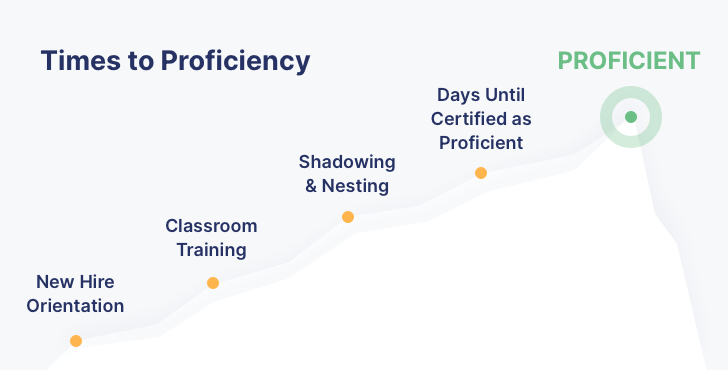Call Center Training: What are Shadowing and Nesting?
What is shadowing?
Shadowing is a phase in call center training where your new hires watch experienced agents take calls. New hires observe how your tenured agents answer calls and use your tools and resources to help the callers.
There are two ways to implement shadowing. First, you can pair new hires with seasoned agents. The new hires can listen into live calls to see how the experienced agents handle the calls. You can even have new hires handle the intake portion of the call and then turn it over to their experienced partner to handle the rest
Another option is to have agents listen to recorded calls that exemplify positive caller experiences. This option allows you to be more selective about the examples you are showing your new hire agents as well as doesn’t require as much manpower.
How long does it take?
The time spent in the shadowing phase varies from company to company. Shadowing can take as much or as little time as it takes for the new hires to feel comfortable attempting calls on their own.
So, how do you know when someone is ready to leave shadowing and move to nesting? One indicator is simple. If you ask an agent if they are ready to try a call on their own and they say yes, they are ready. Trying a few calls will help gauge if they are ready to officially move to nesting.
Some new hires may be hesitant to take calls, but you can encourage them by reinforcing that they have someone right next to them to assist.
What is nesting?
Nesting is a transition phase that prepares employees to take calls on their own. The nesting phase is where new hires apply what they learned during the classroom training and shadowing phases.
This is a hands-on, lower-risk experience. New hires take the calls while a trainer, or a more experienced agent, is beside them to help the new hire in case they need assistance. With this individual attention, the new hires can receive immediate feedback on what they are doing.
How long does it take?
Depending on how complex of calls your call center handles, the nesting phase can take days or weeks. It is contingent on the range of calls your new hires will handle.
So, how do you know when someone is done with nesting? When an agent can go through the basic calls without making mistakes, they are ready to take calls independently. Also, if agents are able to find and use your guides quickly and follow them precisely, they are ready to move on from the nesting phase.
When are they used in training?
There are four phases in call center training. Shadowing and Nesting make up the third phase in training. Here’s a brief explanation of each of these phases.

1. New hire orientation
Before you can train your new agents on how to do their jobs, they need to understand the basics of how the company works. During new hire orientation, your new hires learn about company policies, how to access their employee account, employee benefits, etc.
This step can take as little as a few hours or a couple of days.
2. Classroom (or Virtual) training
Once your employees are briefed on company information, they are ready to be taught the specifics of their job. Onboarding for a call center agent would include information on how to answer calls, how to use resources (i.e. call flows, help guides, troubleshooting guides, etc.), and more detailed instructions.
You can host classroom training in-person or virtually — you’ll just want to make sure you are prepared with the proper tools to train for whichever you choose. Depending on the complexity of your call center, classroom training can take anywhere from days to months.
🔍 Related: 4 common virtual training mistakes (+ how to fix them)
3. Shadowing & nesting
Phase 3 is broken into two parts: shadowing and nesting. The purpose of the two parts is both to decrease the anxiety new reps feel when handling calls and to provide them with hands-on experience.
As stated above, shadowing is when new hires get to watch an experienced agent handle calls while nesting is when the new hires handle calls with an experienced agent watching them.
4. Days until certified proficient
After your new hires complete the first three phases of training, you are ready to let your new agents loose. That means they are handling calls independently without a constant companion to correct them.
However, typically, call center agents aren’t confident following the first three phases of training. Often we see they still need to put callers on hold to ask managers or neighbors questions. They are still dependent on instructors, so they are still in training.
Once an agent can handle calls regularly without needing to stop and ask questions, they are considered proficient or fully trained. At that point, they are capable of doing their job without pulling another employee to help them.
What do you need for the shadowing and nesting phase?
Implementing shadowing and nesting as part of your call center training strategy requires resources. That includes both workers and technology.
Trainers and experienced agents
How many agents does it take to train new hires during the shadowing and nesting phase?
Ideally, you’ll have a one-to-one ratio of experienced agents/trainers to new hires. This way, you can give personalized attention and feedback to your new hire as they learn to take calls.
In some scenarios — specifically in the shadowing phase — you can get away with having a couple of new hire agents listen in on one experienced agent’s calls.
Technology and tools
Whether you are in-office or training remotely, you’ll need technology and tools so that you can perform shadowing and nesting.
Some of the tools you will want include:
- Platform for recording live calls
- Video conferencing application
- Knowledge base or digital document library to store your company’s resources
Call flows and scripts
Both call flows and scripts are ways to help document your processes and procedures for a call center. These are resources your reps can use while on a call.
As your new reps observe tenured reps during shadowing, the new hires can follow these procedures in the call flow. Then, in nesting, they can use these call flows and help guides to complete a call.
Budget
Training can be expensive. And the shadowing and nesting phase can be costly. During the shadowing and nesting phase, you are essentially paying two people to do one job.
You’ll want to set a budget to accommodate this as well as any technology and resources you need to train employees.
🔍 Related: The True Cost of Training a New Agent in the Call Center
How to decrease time to proficiency in your call center training
It takes a lot to train your new call center agents. Ultimately, training takes many phases and the time to proficiency for a new agent means training takes longer than you’d hope for.
When companies have adopted ScreenSteps for their knowledge base and used it as part of their training, they’ve seen decreased training times by up to 90%. One call center went from 60 days to train their employees to proficiency down to just 15 days.
Want to understand more about training and time to proficiency? Learn what training costs your call center and how you can decrease your time to proficiency with the article below.




